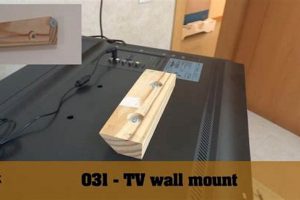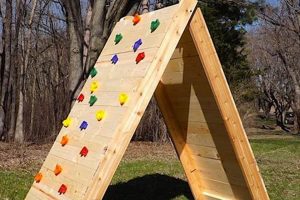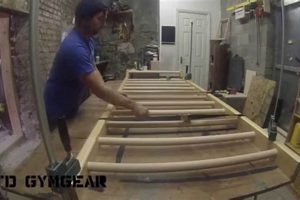Vertical gardens, often self-constructed, represent innovative approaches to incorporating vegetation into interior and exterior spaces. These structures, whether mounted on walls or freestanding, facilitate the cultivation of plants in a compact, upward fashion. An example includes a wooden pallet repurposed to hold soil and various succulents, transforming a blank exterior wall into a vibrant display.
The implementation of such projects offers several advantages, ranging from aesthetic enhancement to environmental improvements. They can act as natural insulators, moderating temperatures within buildings and reducing energy consumption. Historically, similar concepts have been employed in various cultures, demonstrating a long-standing appreciation for integrating nature into built environments.
The subsequent sections will detail essential considerations for planning, building, and maintaining a successful installation. These considerations encompass structural design, plant selection, irrigation techniques, and ongoing care to ensure the project’s longevity and visual appeal.
Tips for Successful Vertical Garden Construction
The following guidelines aim to optimize the construction and maintenance of self-assembled vertical gardens, ensuring both aesthetic appeal and plant health.
Tip 1: Structural Integrity is Paramount: Prioritize the selection of robust materials capable of supporting the weight of the soil, plants, and retained water. Evaluate wall load-bearing capacity before installation to prevent structural damage.
Tip 2: Implement a Drip Irrigation System: Automated watering systems ensure consistent moisture distribution, minimizing water waste and reducing the risk of over or under-watering. Adjust timer settings based on plant species and environmental conditions.
Tip 3: Choose Appropriate Growing Media: Opt for lightweight, well-draining substrates such as a peat moss and perlite mixture. Consider incorporating slow-release fertilizers to provide sustained nutrient supply.
Tip 4: Optimize Plant Selection for Environmental Conditions: Match plant species to the available sunlight, humidity, and temperature. Group plants with similar water and nutrient requirements together to simplify maintenance.
Tip 5: Ensure Adequate Drainage: Incorporate drainage layers at the base of the structure to prevent waterlogging and root rot. Regularly inspect drainage outlets for obstructions.
Tip 6: Monitor for Pests and Diseases: Implement preventative measures, such as insecticidal soap applications, to control common pests. Regularly inspect plants for signs of disease and address issues promptly.
Tip 7: Provide Regular Pruning and Maintenance: Trim overgrown plants to maintain the desired aesthetic and prevent shading of lower foliage. Remove dead or diseased leaves to promote plant health.
Careful adherence to these recommendations will promote the long-term health and visual appeal of any vertical garden, transforming a simple wall into a thriving ecosystem.
The following section addresses the specific challenges of maintaining vertical gardens in various climates.
1. Structural Stability
In the context of self-constructed vertical gardens, structural stability is paramount. The integrity of the supporting framework directly influences the longevity, safety, and overall aesthetic of the living installation. Compromised structural elements can lead to collapse, resulting in damage to property, plant loss, and potential injury.
- Material Selection and Load Capacity
The choice of materials, such as wood, metal, or plastic, must align with the anticipated weight of the system when fully saturated with water. Factors include the substrate’s density, the mature size of the plants, and the weight of the irrigation system. A failure to accurately calculate load requirements can result in warping, cracking, or catastrophic failure of the support structure. For example, a wooden frame inadequately treated for moisture exposure may rot and weaken, leading to collapse.
- Wall Anchoring and Support Systems
The method used to affix the vertical garden to the wall or supporting structure is critical. Improper anchoring can place undue stress on the wall itself, potentially leading to structural damage to the building. Appropriate anchoring strategies involve using fasteners rated for the expected load, distributed evenly across the structure’s footprint. A large system attached with only a few poorly placed screws may cause significant strain and eventual detachment from the wall.
- Water Retention and Drainage Considerations
The design must accommodate water retention and drainage without compromising structural integrity. Excessive moisture accumulation can accelerate the degradation of supporting materials, particularly wood. Effective drainage mechanisms, such as weep holes or drainage layers, are essential to prevent waterlogging and promote material longevity. Failure to incorporate adequate drainage can lead to fungal growth, corrosion, and weakening of the support structure over time.
- Environmental Factors and Weather Resistance
Outdoor vertical gardens are subjected to environmental stressors such as wind, rain, and temperature fluctuations. Selecting materials resistant to weathering, corrosion, and UV degradation is essential for long-term durability. Protective coatings or treatments may be necessary to prolong the lifespan of the structure. A poorly constructed system exposed to harsh weather may experience accelerated deterioration, posing a safety hazard and necessitating frequent repairs.
The relationship between structural stability and the successful construction of self-made vertical gardens underscores the importance of meticulous planning and careful execution. A structurally sound installation provides a stable foundation for plant growth, minimizes maintenance requirements, and ensures the safety and longevity of the living wall.
2. Appropriate Irrigation
Effective irrigation is a critical determinant of success in self-constructed vertical gardens. It directly impacts plant health, water conservation, and the overall sustainability of the installation. The design and implementation of a suitable irrigation system must account for various factors to ensure optimal performance.
- Water Distribution Uniformity
Uniform distribution ensures all plants receive adequate moisture. Variations in water delivery can lead to some plants being over-watered while others suffer from drought stress. A well-designed drip irrigation system, with emitters spaced appropriately, promotes even growth. For example, plants at the top of a tall vertical garden require more frequent or higher volume watering than those at the bottom due to gravity’s effect.
- Water Conservation Strategies
Efficient water use is essential for both environmental sustainability and reduced operating costs. Implementing features such as rain sensors, timers, and soil moisture sensors optimizes water delivery. Recirculating systems, which capture and reuse drainage water, further minimize water consumption. In arid climates, these strategies become even more crucial for the viability of the vertical garden.
- System Automation and Control
Automated irrigation systems reduce manual labor and ensure consistent watering schedules. Timers can be programmed to deliver water at optimal times, such as early morning or late evening, to minimize evaporation. Some systems integrate with weather data to adjust watering schedules based on precipitation forecasts. This automation provides a level of precision that manual watering cannot achieve.
- Preventing Waterlogging and Root Rot
Overwatering can lead to waterlogging and root rot, particularly in poorly drained systems. Incorporating drainage layers and selecting a well-draining substrate are vital. Adjusting irrigation schedules based on plant needs and environmental conditions helps prevent excessive moisture accumulation. Regular inspection of the drainage system ensures it remains free of obstructions, allowing excess water to escape effectively.
The careful consideration and implementation of these irrigation facets are essential for the long-term health and visual appeal of any self-constructed vertical garden. A well-designed irrigation system not only sustains plant life but also contributes to the overall efficiency and sustainability of the installation.
3. Suitable Plant Selection
The selection of appropriate plant species represents a critical juncture in the execution of self-constructed vertical gardens. The compatibility between chosen vegetation and the inherent conditions within the designed structure directly influences the long-term viability, aesthetic qualities, and maintenance requirements of the installation. Incompatible plant selection inevitably leads to diminished aesthetic appeal, increased maintenance burdens, and potential system failure. For instance, shade-loving ferns will not thrive in a south-facing vertical garden receiving direct sunlight, regardless of meticulous irrigation practices or structural integrity. The ramifications extend beyond mere plant survival; improper selection can foster disease outbreaks or pest infestations, affecting the entire ecosystem within the vertical structure.
Practical application of this understanding involves a thorough assessment of environmental parameters, including light exposure, temperature fluctuations, humidity levels, and air circulation patterns. Subsequently, plant species should be matched to these conditions based on their specific ecological needs. Succulents, for example, are frequently employed in arid environments due to their drought tolerance and low maintenance requirements. Conversely, moisture-loving plants, such as certain varieties of moss, are better suited for locations with high humidity and consistent moisture availability. Successful integration necessitates considering the mature size of plants to prevent overcrowding and ensure adequate space for root development. Furthermore, grouping plants with similar needs streamlines watering and fertilization schedules, enhancing efficiency.
The challenges associated with suitable plant selection in DIY vertical gardens often stem from a lack of botanical knowledge or insufficient consideration of long-term maintenance requirements. However, by prioritizing thorough research and matching plant characteristics to the specific environmental conditions of the vertical structure, it is possible to create thriving and sustainable installations. Ultimately, successful plant selection is not merely a cosmetic consideration, but a foundational element that underpins the health, longevity, and overall success of any self-constructed living wall.
4. Effective Drainage
Effective drainage constitutes a fundamental aspect of successful self-constructed vertical gardens. Its implementation directly influences plant health, structural integrity, and the overall longevity of the installation. Inadequate drainage mechanisms often lead to waterlogging, root rot, and eventual system failure. The absence of properly designed drainage systems is therefore a critical oversight in any “live wall diy” project.
- Prevention of Root Rot and Fungal Diseases
Sustained saturation of the root zone creates an anaerobic environment, predisposing plants to root rot and fungal diseases. Effective drainage facilitates the removal of excess water, preventing the development of these conditions. For example, incorporating a gravel layer at the base of a vertical garden module promotes water flow away from plant roots, reducing the risk of fungal infections common in overly moist environments. The absence of such a layer can quickly result in plant decline and necessitate costly replacements.
- Maintenance of Substrate Aeration
Well-drained soil ensures sufficient air circulation around plant roots, a critical factor for nutrient uptake and overall plant vigor. Waterlogged soils restrict oxygen availability, hindering root function and leading to nutrient deficiencies. An example of effective aeration management is the use of a porous growing medium, such as a peat moss and perlite mixture, combined with drainage holes in the vertical garden structure. This combination facilitates both water drainage and air circulation, optimizing root health.
- Protection of Structural Components
Excessive moisture accumulation can accelerate the degradation of structural materials, particularly wood. Properly designed drainage systems prevent water from pooling and causing rot or corrosion. The integration of a waterproof membrane behind the vertical garden structure, coupled with adequate drainage channels, protects the supporting wall from water damage. This protection extends the lifespan of the vertical garden and prevents costly repairs to the underlying structure.
- Control of Nutrient Leaching and Water Quality
Excessive water runoff can lead to nutrient leaching, depleting the substrate of essential elements needed for plant growth. A well-designed drainage system, coupled with appropriate fertilization practices, minimizes nutrient loss and promotes sustainable plant growth. Implementing a recirculating system that captures and reuses drainage water allows for the recovery of leached nutrients, reducing the need for frequent fertilization and minimizing environmental impact.
The incorporation of effective drainage mechanisms is not merely an ancillary detail in “live wall diy”, but a core component that directly impacts the health, longevity, and sustainability of the installation. Overlooking this aspect can lead to significant maintenance challenges, plant loss, and structural damage, ultimately undermining the success of the vertical garden project.
5. Ongoing Maintenance
The enduring viability of self-constructed vertical gardens hinges upon consistent and diligent maintenance practices. These interventions address both biotic and abiotic factors that influence the health, aesthetic appeal, and structural integrity of the installation. Neglecting maintenance protocols precipitates plant decline, structural degradation, and an overall diminishment of the intended aesthetic.
- Regular Pruning and Plant Management
Pruning serves to control plant size, promote air circulation, and remove dead or diseased foliage. This practice prevents overcrowding, optimizes light penetration, and mitigates the risk of pest or disease outbreaks. For instance, unchecked growth in a dense vertical garden can shade lower-level plants, leading to their decline. Regular pruning ensures balanced growth and maintains the desired visual composition. It also allows for the timely removal of invasive species that may compromise the health of the ecosystem.
- Pest and Disease Control
Vertical gardens, like all plant ecosystems, are susceptible to infestations and diseases. Regular inspection and prompt treatment are crucial to prevent widespread damage. Implementing integrated pest management (IPM) strategies, which combine biological controls, cultural practices, and targeted chemical applications, minimizes environmental impact while effectively managing threats. A sudden aphid infestation, if left untreated, can quickly decimate a vertical garden, highlighting the importance of vigilant monitoring and swift intervention.
- Nutrient Replenishment and Fertilization
Over time, nutrients in the growing medium deplete, necessitating periodic replenishment through fertilization. Selecting appropriate fertilizers based on plant needs and environmental conditions is essential. Slow-release fertilizers provide a sustained source of nutrients, minimizing the risk of over- or under-fertilization. A lack of essential nutrients can manifest as chlorosis (yellowing of leaves) or stunted growth, indicating the need for immediate intervention to restore nutrient balance.
- Irrigation System Monitoring and Adjustment
Consistent monitoring of the irrigation system ensures optimal water delivery and prevents waterlogging or drought stress. Adjusting irrigation schedules based on seasonal changes, plant growth stages, and environmental conditions is crucial. Clogged emitters or leaks can disrupt water distribution, leading to localized dryness or saturation. Regular inspection and maintenance of the irrigation system are essential to prevent such issues and maintain uniform moisture levels throughout the vertical garden.
These facets of ongoing maintenance are inextricably linked to the long-term success of any self-constructed vertical garden. A proactive and consistent approach to maintenance ensures that the initial investment yields enduring benefits, preserving the aesthetic appeal, ecological function, and structural integrity of the installation. This approach underscores the importance of planning for maintenance from the outset of any “live wall diy” project.
Frequently Asked Questions
The following addresses common inquiries regarding the planning, construction, and maintenance of self-assembled vertical gardens. These responses aim to clarify potential uncertainties and provide practical guidance.
Question 1: What structural considerations are paramount in “live wall diy”?
The selection of materials with adequate load-bearing capacity is critical. Assess the weight of the saturated substrate, mature plant size, and irrigation system components to ensure structural integrity. Proper wall anchoring is essential to prevent detachment and potential damage.
Question 2: How does one effectively manage irrigation in “live wall diy” scenarios?
Drip irrigation systems are recommended for uniform water distribution. Employ timers and soil moisture sensors to optimize water delivery and prevent overwatering. Consider water recirculation systems to minimize water waste and nutrient runoff.
Question 3: What factors govern appropriate plant selection for “live wall diy”?
Match plant species to the environmental conditions, including light exposure, temperature, and humidity. Group plants with similar water and nutrient requirements. Consider the mature size of plants to prevent overcrowding and ensure adequate root development.
Question 4: Why is drainage important for a “live wall diy” structure?
Adequate drainage prevents waterlogging, root rot, and fungal diseases. Incorporate drainage layers at the base of the structure and utilize well-draining substrates. Regular inspection of drainage outlets is necessary to ensure proper function.
Question 5: What ongoing maintenance is required for “live wall diy” installations?
Regular pruning controls plant size and promotes air circulation. Implement integrated pest management (IPM) strategies to address infestations. Replenish nutrients through appropriate fertilization methods. Monitor the irrigation system to ensure proper water distribution.
Question 6: How can one address common challenges encountered in “live wall diy”?
Thorough planning is essential. Understand the specific needs of the chosen plant species and the limitations of the structural support. Implement preventative measures to mitigate pest and disease risks. Regular monitoring and timely intervention are key to long-term success.
These answers highlight the importance of careful planning, appropriate material selection, and diligent maintenance in self-constructed vertical gardens. Adherence to these guidelines increases the likelihood of a successful and sustainable installation.
The following section will explore specific case studies of successful vertical garden implementations.
Conclusion
This exposition has detailed the critical aspects of successful self-constructed vertical gardens. From structural considerations and irrigation techniques to plant selection, drainage management, and ongoing maintenance, each element contributes to the overall health and longevity of the installation. A thorough understanding of these principles is essential for mitigating potential challenges and maximizing the benefits of “live wall diy”.
The creation of a thriving vertical garden requires not only technical skill but also a commitment to continuous learning and adaptation. With diligent planning and execution, one can transform ordinary spaces into vibrant ecosystems, fostering environmental enrichment and aesthetic enhancement. Further research into specific plant species and local climatic conditions is encouraged to ensure the continued success and sustainability of these innovative installations.







